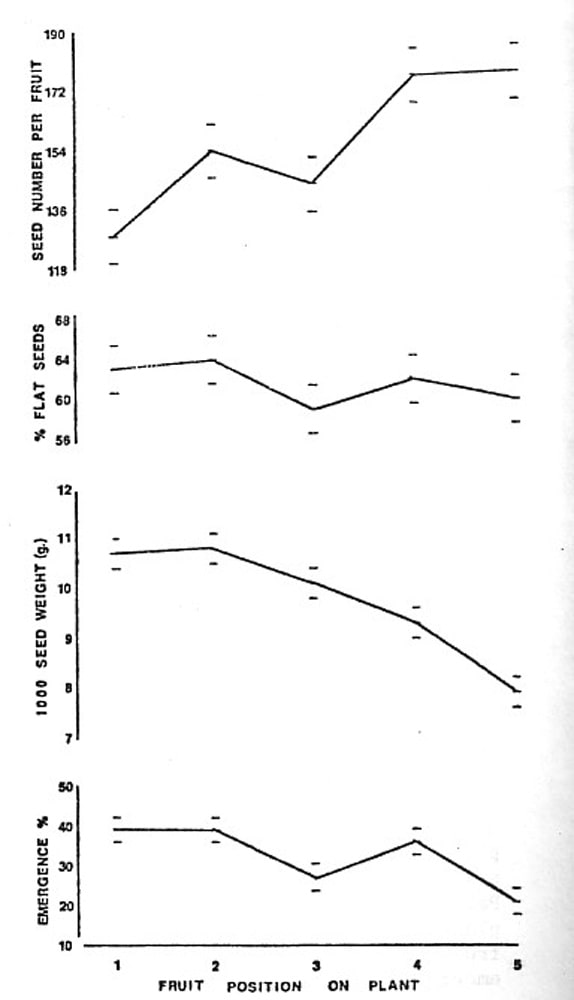Cucurbit Genetics Cooperative Report 4:4-5 (article 2) 1981
M.D. Edwards and R. L. Lower
University of Wisconsin, Madison, WI 53706
Considerable variability has been observed for emergence percentage and other seed characteristics within a heterogeneous population of compact cucumber genotypes, as reported in a previous study (CGC #4, pp. 2-4). The present study was designed to investigate the extent to which different fruit on the same plant vary for seed quality characteristics.
The same heterogeneous, open-pollinated population of compact plants served as the source of fruit for this and the previous study. Twenty-five plants were selected which had at least five fruit positioned sequentially along the mainstem or along a sequence of mainstem and lateral branches. Although the time frame in which these fruit had been set could not be exactly established, the crown fruit was clearly set first in the season and the apical-most set much later in the season, on each plant. The 125 single-fruit samples obtained were handled as described in CGC #4, pp. 2-4. Seeds were evaluated for emergence in steam sterilized sand in wooden flats. Replication 1 was germinated in a 25°C growth chamber with 12 hrs. of fluorescent illumination daily and replication 2 was germinated on a greenhouse bench under fluctuating but considerably lower temperatures (15 to 27°C).
Partitioning of variability for emergence percentage among the 25 families of five sequentially-positioned fruit is presented in Table 1. The greatest mean square was observed for replication effects. This was not unexpected since replication was conducted across quite different environmental conditions. Interestingly, parent plant x replication interaction contributed very little to observed variability for emergence percentage. Parent plants, fruit within plants, and seed type within fruit x plants were all highly significant sources of variation as tested by their appropriate error terms. Parent plant differences were also highly significant as tested by fruit within plants as an error term. Therefore, the variability between fruit within the same plants for emergence percentage.
Correlation between plant mean seed characteristics are presented in Table 2. Observed associations are as reported in the previous study, but values for specific correlations are of considerably greater magnitude among plant means than among individual fruit.
Means for seed characteristics for each fruit position are depicted in Figure 1. Total seed number tended to increase over the season while mean seed weight and emergence percentage tended to decrease and percent flat seeds remained essentially unchanged.
Although there is clearly variation for seed quality among fruit from individual plants, the factors contributing to these differences could not be determined from this study. Such variation could conceivably arise from a number of influences including: 1) influence of paternal genetic complement, 2) changes in climatic factors associated with seed development and filling, and 3) variable maternal influence attributable to fruit position on the plant or changes in competition for available substrates over the season.
Table 1. ANOVA for emergence percentage among five fruit from each of 25 plants.
Source |
df |
Mean squares for emergence |
| Plant | 24 | 0.56** |
| Replication | 1 | 5.80** |
| Error A | 24 | 0.7 |
| Fruit within plants | 100 | 0.22** |
| Error B | 100 | 0.05 |
| Seed type within fruit x plants | 125 | 0.05** |
| Error C | 125 | 0.03 |
** significant at the .01 level.
Table 2. Correlations between plant mean seed characteristics (n = 25).
Trait |
% flat seeds |
1000 seed wt. |
Emergence % |
| Seed number per fruit | 0.59** | 0.41* | 0.61** |
| % “flat” seeds | 0.70** | 0.78** | |
| 1000 seed weight | 0.62** |
*,** significant at the .05 and 0.1 levels, respectively.
